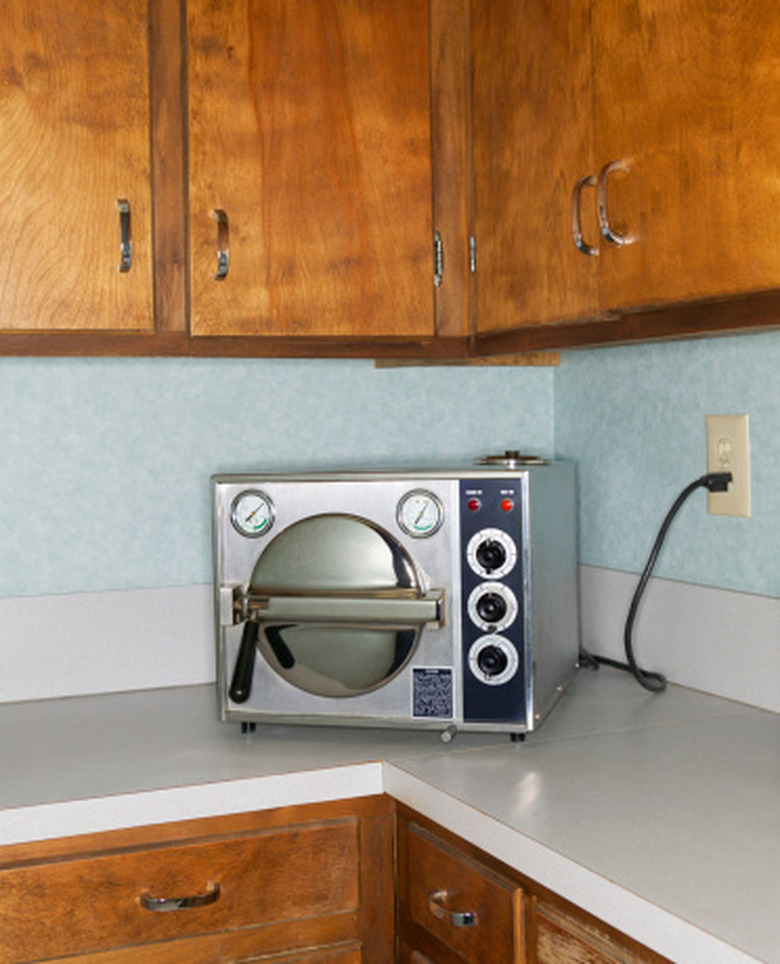How To Calibrate An Autoclave
Medical equipment is commonly sterilized in autoclaves. They are also used in microbiology laboratories. Autoclaves are available in many sizes. The smallest is a stovetop pressure cooker. Countertop models are used in dentist's offices and small medical clinics. Large solid-state controlled autoclaves are common in laboratories and hospitals. All autoclaves have temperature and pressure gauges, as well as a timer. Quarterly calibration of the autoclave timer and gauges is important to insure that proper sterilization is occurring.
Timer Calibration
Step 1
Set the timer on the autoclave for a full cycle. Hold the stopwatch and be prepared to click it.
Step 2
Turn on the autoclave and the stopwatch simultaneously.
Step 3
Repeat the process if the time and the stopwatch do not match.
Step 4
If the autoclave timer differs from the stopwatch time by more than 30 seconds, post an appropriate correction factor directly on the autoclave.
Step 5
Note the calibration results in a logbook.
Temperature Calibration
Step 1
Place the maximum registering thermometer near the built-in temperature sensor.
Step 2
Load and operate the autoclave as usual.
Step 3
Record the maximum autoclave temperature according to the built-in temperature display.
Step 4
Let the autoclave cool.
Step 5
Remove the maximum registering thermometer from the autoclave and record the temperature reading in the logbook.
Step 6
Record the discrepancy if the maximum temperature of the built-in display is different from the maximum temperature on the registering thermometer.
Step 7
Post a correction factor on the autoclave control panel if the temperatures were different.
Pressure Calibration
Step 1
Calibrate the timer and temperature gauges before these steps.
Step 2
Load and operate the autoclave as usual. When the temperature display shows 121 degrees Celsius, the pressure gauge should show 15 pounds per square inch (15 psi).
Step 3
Record the discrepancy if there is any.
Step 4
Mark the correct point for 15 psi on the cover of the gauge and post a correction factor on the autoclave if this is not true.
Things Needed
- Stopwatch
- Logbook
- Maximum registering thermometer
TL;DR (Too Long; Didn't Read)
Be patient and allow the autoclave to run full cycles when calibrating. Many errors in calibrations occur when adjustments are made before conditions have stabilized. Calibration should be part of the laboratory routine. A logbook for recording time, temperature, and operator should be kept near the autoclave at all times. A maximum registering thermometer is a thermometer that displays the highest temperature obtained until manually reset.
Warning
During calibration, it is important that the autoclave is loaded with the usual items to be sterilized. It is also important to operate the autoclave during calibration the same way you would during normal use. The calibration is only as accurate as the standards that are used.
Cite This Article
MLA
Beyer, Sheryl. "How To Calibrate An Autoclave" sciencing.com, https://www.sciencing.com/calibrate-autoclave-8673376/. 24 April 2017.
APA
Beyer, Sheryl. (2017, April 24). How To Calibrate An Autoclave. sciencing.com. Retrieved from https://www.sciencing.com/calibrate-autoclave-8673376/
Chicago
Beyer, Sheryl. How To Calibrate An Autoclave last modified March 24, 2022. https://www.sciencing.com/calibrate-autoclave-8673376/
